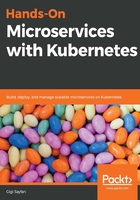
Summary
In this chapter, you received a whirlwind tour of Kubernetes and got an idea of how well it aligns with microservices. The extensible architecture of Kubernetes empowers a large community of enterprise organizations, startup companies, and open source organizations to collaborate and create an ecosystem around Kubernetes that multiplies its benefits and ensures its staying power. The concepts and abstractions built into Kubernetes are very well suited for microservice-based systems. They support every phase of the SDLC, from development, through testing, and deployments, and all the way to monitoring and troubleshooting. The Minikube project lets every developer run a local Kubernetes cluster, which is great for experimenting with Kubernetes itself, as well as testing locally in an environment that is very similar to the production environment. The Helm project is a fantastic addition to Kubernetes and provides great value as the de facto package management solution. In the next chapter, we will dive into the world of microservices and learn why they are the best approach for developing complex and fast-moving distributed systems that run in the cloud.